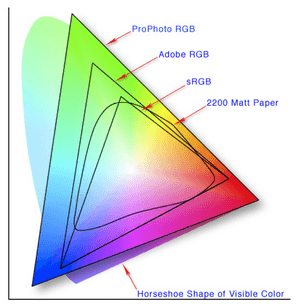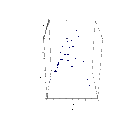Gamut facts for kids
In computer graphics and photography, the gamut (or color gamut) is a specific group of colors. It usually means the colors that a device, like a screen or a printer, can show or reproduce accurately.
Sometimes, "gamut" can also mean all the colors found in a single picture.
Contents
What is a Color Gamut?
The word gamut comes from music. In old Latin, "gamut" meant the full range of musical notes used to make melodies. Around the 1850s, people started using the word for a range of colors or shades. For example, someone might say a type of rock has a large "gamut of hues."
In color theory, a device's gamut is the part of the total color space that it can display. Think of the total color space as all the colors the human eye can see. A device's gamut is like its own special box of colors within that bigger space.
When some colors cannot be shown by a specific color model (like the colors a printer can make), those colors are called out of gamut.
When you work with a digital image, it's often saved using the RGB color model (Red, Green, Blue). If you want to print this image, it needs to be changed from RGB to the printer's CMYK color space (Cyan, Magenta, Yellow, Black). During this change, any colors that the printer can't make (out of gamut) are changed to the closest colors it can make. So, the printed picture is a close version of the original.
How Gamuts Are Shown
Color gamuts are often shown as areas within the full range of visible colors. The entire range of colors we can see is usually drawn on a CIE 1931 chromaticity diagram, which looks a bit like a horseshoe.
The gamut also depends on how bright the colors are. So, a complete gamut is best shown in a 3D space, not just a flat picture.
Comparing Gamuts of Different Devices
Here's a look at how different devices show colors, from those with a very wide range of colors to those with a smaller range:
- A Laser video projector uses three lasers to create colors. Lasers make very pure, single-color primaries. This allows them to produce the widest range of colors available today. Using more than three lasers can make the color range even bigger.
- Photographic film can show a wider range of colors than a typical television or computer screen.
- Older CRT displays have a color gamut that looks roughly like a triangle. This triangle covers a good part of the colors we can see. In CRTs, the limits come from the special powders (phosphors) on the screen that create red, green, and blue light.
- Printing usually uses the CMYK color space (cyan, magenta, yellow, and black). People have tried to make printing show more colors by adding extra inks that are not primary colors.
- A monochrome display (like an old black and white screen) only shows shades of one color. Its color gamut is just a single line in the color space.
You can explore an interactive demo about color gamut mapping from Stanford University CS 178 here: interactive Flash demo.
Images for kids
See also
 In Spanish: Gama de color para niños
In Spanish: Gama de color para niños



